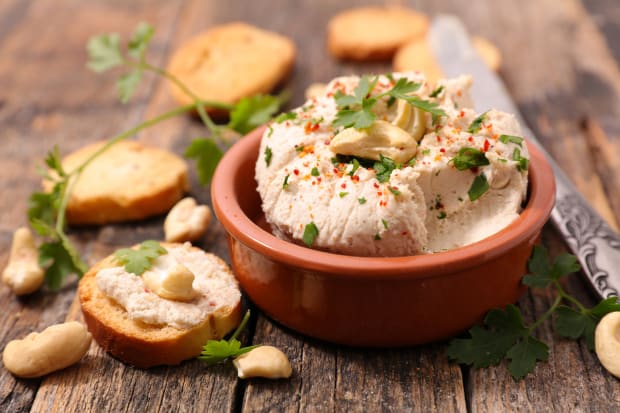- Like
- SHARE
- Digg
- Del
- Tumblr
- VKontakte
- Flattr
- Buffer
- Love This
- Save
- Odnoklassniki
- Meneame
- Blogger
- Amazon
- Yahoo Mail
- Gmail
- AOL
- Newsvine
- HackerNews
- Evernote
- MySpace
- Mail.ru
- Viadeo
- Line
- Comments
- Yummly
- SMS
- Viber
- Telegram
- JOIN
- Skype
- Facebook Messenger
- Kakao
- LiveJournal
- Yammer
- Edgar
- Fintel
- Mix
- Instapaper
- Copy Link
I’m not a fan of vegan “substitutes” such as vegan cheese or vegan pizza. For some reason, many vegan “substitute” foods are made with horrible ingredients and lots of chemicals. (Try reading the ingredient list on a vegan pizza—if you dare!) But this one is different. Very different. In fact, it’s the only vegan cheese I’ve had that I actually like. Here’s why:
First of all, it’s made from one of my favorite foods, nuts (see “Featured Ingredient,” below). Secondly—unlike lots of imitation cheeses—it tastes extraordinarily good. And finally, it contains really healthy ingredients such as probiotics, and none of the chemical-tasting pseudo-ingredients often used in fake foods. As my grandmother used to say, what’s not to like?
Making your own vegan cheese—or “cheez,” as Chef Jeanette likes to call it—isn’t really difficult, but it does take some time (for soaking and culturing). And there’s no getting around it—you’ll need either a high-speed blender or an industrial-strength one. But here’s the good news: The flavors of these “cheezes” are so good, you won’t miss the real thing even a little bit.
And let’s face it, for many people, these cheezes are just going to be a lot easier to digest than traditional cheese. I love the “double-batch” approach because it produces enough cheez to ensure you’ll be able to nosh for quite a while. (Why go to all the trouble if it only lasts one evening?)
These soft vegan cheezes are amazing on a simple (gluten-free) cracker, but they also work as a bagel schmear, to liven up sandwiches or wraps, as a dip for crudités or fruit slices, or even dolloped over crisp green salads (one of my personal favorites). Enjoy!
Notes from the Clean Food Coach:
A countertop is fine for culturing in the summer months. When it’s cooler, I put my cheez in the microwave with the stove light on underneath to make it a little warmer than room temp.
Culturing is an art in itself. For most people, the cheez will taste “right” when it’s got a slight sharp or sour tang. You can also eat it earlier than 24 hours—before you can taste the sour note—or let it rest for an additional 12 hours to increase the sharpness, according to your personal preference. Cooler temperatures will slow the culturing process, and warmer temps will speed it up. Adjust your times accordingly.
Featured Ingredient: Macadamia Nuts
Here’s what Dr. Robert Atkins (of Atkins Diet fame) had to say about macadamia nuts in Health Revelations, way back in November 1996: “I’ve always looked for a food that could serve as a meal in itself—nutritionally complete and safe as a snack. All you need to do is keep a jar of macadamia nuts handy. I snack on them whenever a meal is late … I simply will not board an airplane without them.”
Now I wouldn’t go so far as to say that macadamia nuts are “the” perfect food, but they sure are a good one. The oil in macadamia nuts is more than 80 percent monounsaturated, higher than any other nut oil, even olive oil (about 75 percent monounsaturated). Monounsaturated fat is the main fat in the Mediterranean diet, which has been shown in virtually every research study to be associated with lower levels of heart disease and cancer, not to mention longer life spans. In the famous Lyon Diet Heart Study, those following a Mediterranean diet, with its high intake of monounsaturated fat, experienced three times the reduction in risk for heart disease than what is achieved by statin drugs, and they had a 45 percent lower overall risk of death. There’s not much question that monounsaturated fat—like the kind found in macadamia nuts—is awfully good for you.
These nuts also contain calcium, phosphorus, and magnesium (for strong bones and teeth), heart-healthy potassium, a couple of grams of fiber per ounce, and a small amount of selenium, a trace mineral with significant anticancer properties. Plus they contain phytosterols, including beta-sitosterol, which has been shown to help lower bad cholesterol and to promote prostate health, possibly by its anti-inflammatory activity.
Macadamia nuts are very high in calories—about 204 per ounce—so if you’re trying to lose weight, don’t go munching them right out of the jar. Instead, substitute an ounce of the nuts two or three times a week for an equivalent number of calories from other sources.
My family’s favorite nut mix is cashews and macadamias with a few Brazil nuts or almonds thrown in just for good measure. We always keep a jar with that exact homemade mix available for (limited!) snacking.
Click here for the Double Batch Treenut Cheez: Cranberry Orange Pecan and Everything Bagel Flavors recipe.


